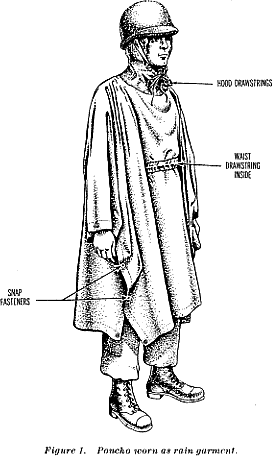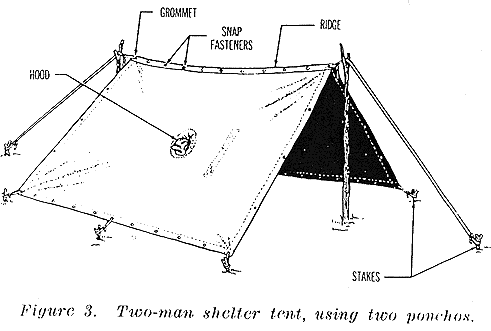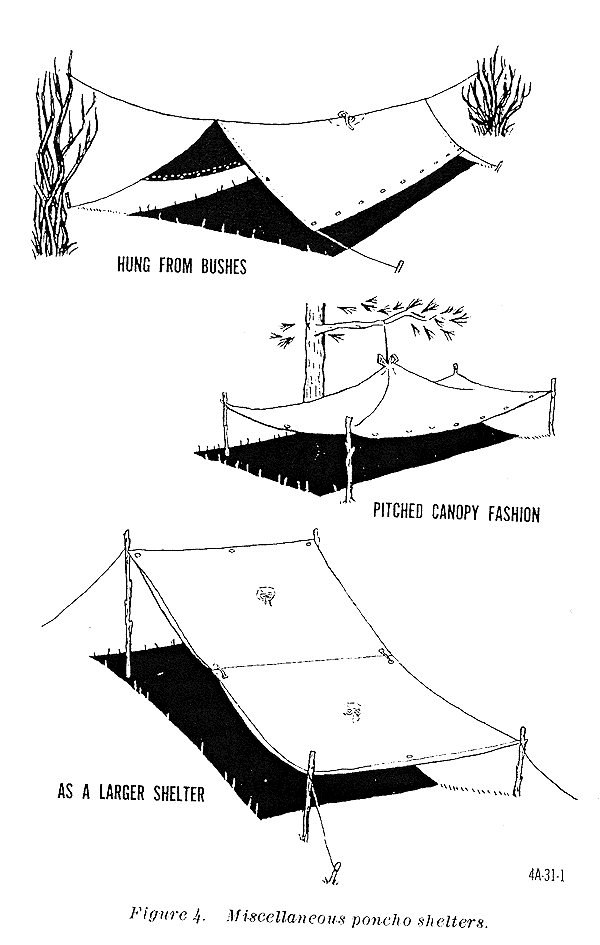http://www.hardscrabblefarm.com/vn/poncho.html
The Poncho
From FM 21-15, Care and Use of Individual Clothing and Equipment, January 1966
Chapter 3
BIVOUAC EQUIPMENT
13. Poncho
The poncho, with hood, is made of coated nylon cloth and is waterproof. It is roughly rectangular in shape with the long sides parallel and the short sides slightly curved. The hood and the opening for the neck are located at the center of the rectangle Drawstring's are provided at, the hood and waist.
- Use. Use the poncho as a rain garment, shelter, ground cloth, and sleeping bag.
-
Rain garment. The poncho may be worn as a raincape with the arms inside or it may be worn with the arms outside for freedom of movement(fig. 1). To put the poncho on, slip it over the head. If the poncho hood is to be worn, adjust the hood drawstring to fit. The helmet and/or liner are worn over the hood. Adjust waist drawstring by fitting poncho around waist and tying drawstring at the back. Fasten snap fasteners together on each side of the poncho. To prevent poncho from napping in high winds, make certain all fasteners are fastened.
Note. The poncho may not be suitable or adequate for certain personnel under varied conditions. If this is the case, the user may use the wet-weather parka (FSN 8505-171-1420) and the wet-weather overalls (FSN 8405-268-8048).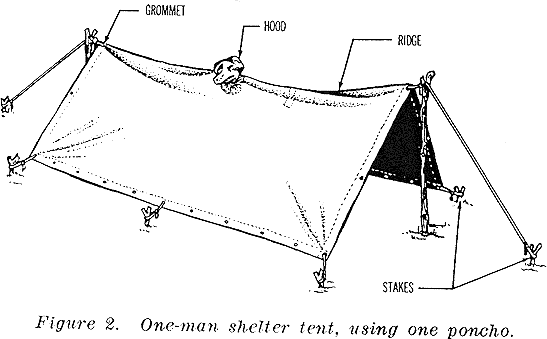
- Shelters. Various types of shelters and lean-tos may be made by attaching ponchos to trees, tree branches, bushes, sticks, or poles. Always dig a ditch under the eaves of the shelter to drain off rainwater which drips from the edges of the poncho.
- Ground cloth. The poncho may be used as a ground cover for shelters and as a waterproof barrier between the ground and sleeping bag.
- Sleeping bag. The poncho may be used as a sleeping bag either by itself or in conjunction with a blanket (fig. 5). Spread the poncho fiat on the ground, making sure the hood opening is tightly closed. If a blanket is used, place it on the top of the poncho, fold (lie poncho and blanket in half lengthwise, and fasten the snap fasteners together. If the poncho is being used without a blanket, snap the sides together along their entire length and tuck the foot end under to keep the feet from sticking out.
Caution. (Do not fasten the snap fasteners together when the poncho is used as as a sleeping bag in combat areas; it cannot be opened quickly.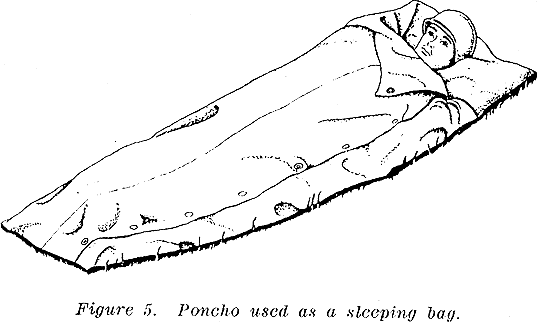
-
- Folding and Packing. The poncho can be folded for carry with individual load-carrying equipment, or for carry over the pistol belt. It can "be carried in a duffel bag or inside the field pack if space permits. In these cases, it can be folded in any appropriate manner, but care should be taken not to damage it, in folding or by pressure against sharp or rough objects in the pack or bag.
- To fold the poncho for carry with individual load-carrying equipment, refer to figure 6 and proceed as follows:
- Lay the poncho out flat (1) with waist drawstring identification label up. Pull hood through the neck opening and flatten toward either curved side. Tie waist drawstring ends together.
- Bring both curved edges of poncho toward neck opening until the edges are about 2 inches apart (2).
- Working at either folded side, bring folded edge toward center of poncho until it overlaps curved edge of opposite side by about 4 inches (3). Fold other side so that all folded edges are even (4).
- Fold either end toward the opposite end so that the ends are about 15 inches apart (5).
- Fold the same end again, making sure the fold is about 2 inches shorter than the previous fold (6).
- Roll the folded end, making as tight a roll as possible. A roll approximately 15 inches wide and 9 inches in circumference should result (8).
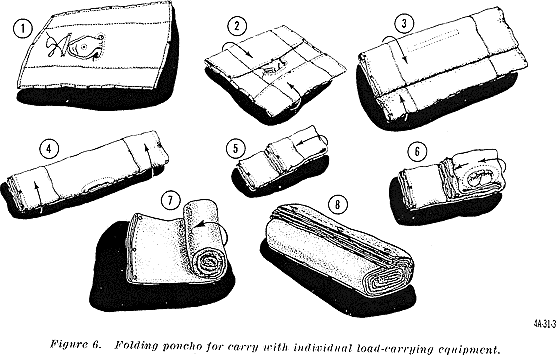
- To fold the poncho for carry over the pistol belt only, refer to figure 7 and proceed as follows:
- Lay poncho out flat (1) with waist drawstring and identification label up. Pull hood through neck opening and flatten toward either curved side. Knot the waist drawstring at each tunnel grommet to prevent the drawstring from shifting while folding. The ends of the drawstring should extend equal lengths 'beyond poncho edges. The two drawstring ends should always be kept free during folding operation.
- Fold the poncho in half by bringing the two curved edges together, keeping drawstring between folds (2).
- Fold toward curved edge stopping at last grommet, leaving entire curved edge projecting (3).
- Fold again in same direction (4), keeping folded edges even. Fold again (5).
- Fold each end toward center, leaving about 3 indies between ends (6).
- Fold in same direction, end to end (7).
- Tie poncho securely in place over pistol belt with drawstrings near center of the folded poncho (8).
- Carry poncho over pistol belt as illustrated (9).
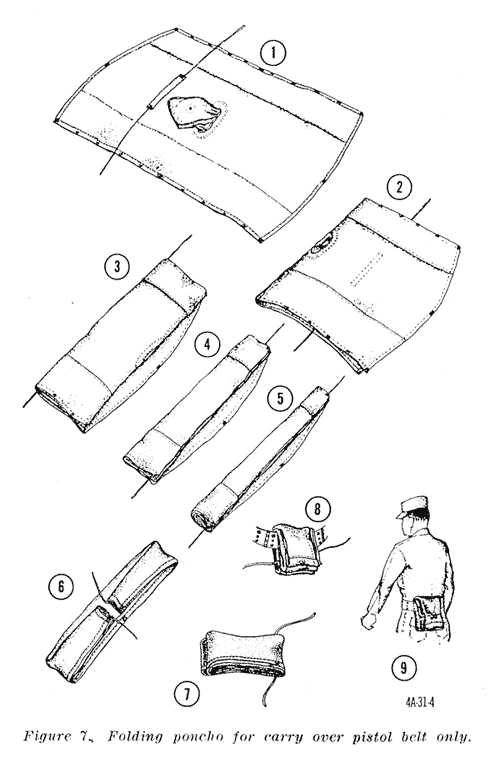
- To fold the poncho for carry with individual load-carrying equipment, refer to figure 6 and proceed as follows:
- Inspection and Repair. Inspect poncho for holes, rips, and tears by holding it up to the light.
'Mountain > Outdoor Gear' 카테고리의 다른 글
| LED LENSER H7 7497 (0) | 2010.06.30 |
|---|---|
| 대형 배낭의 선택 - MR G5000, 다나 브릿저, 보라80 (0) | 2009.12.30 |
| [MR] Mistery Ranch - Sizing (0) | 2009.08.28 |
| [스크랩] 겨울등산의류 원단정보 (0) | 2009.03.12 |
| [스크랩] 동계 비박장비 (0) | 2008.04.03 |
